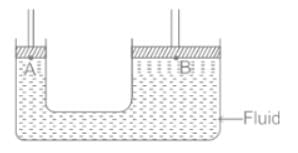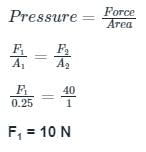EmSAT Achieve Exam > EmSAT Achieve Questions > A hydraulic lift has two pistons with area 1 ...
Start Learning for Free
A hydraulic lift has two pistons with area 1 m2 and 0.25 m2. What is the force exerted by the smaller piston when 40 N is placed on the larger piston?
- a)160 N
- b)10 N
- c)40 N
- d)Cannot be determined
Correct answer is option 'B'. Can you explain this answer?
Verified Answer
A hydraulic lift has two pistons with area 1 m2and 0.25 m2.What is the...
CONCEPT:
- Pascals Law: In a fluid at rest in a closed container, the external static pressure applied on a confined liquid is transmitted without loss to every portion of the fluid and to the walls of the container.
- In Pascal's law, the effect of gravity is neglected.
CALCULATION:
Given that A1 = 0.25 m2 and A2 = 1 m2; F2 = 40N F1 = ?

From Pascal's Law, the pressure inside the liquid will be equal at every place. So the pressure at A and B will be equal.
PA = PB

So the correct answer is option 2.
Most Upvoted Answer
A hydraulic lift has two pistons with area 1 m2and 0.25 m2.What is the...
Understanding the Hydraulic Lift Principle
A hydraulic lift operates based on Pascal's principle, which states that when pressure is applied to a confined fluid, the pressure change is transmitted undiminished throughout the fluid.
Given Data
- Area of the larger piston (A1) = 1 m²
- Area of the smaller piston (A2) = 0.25 m²
- Force on the larger piston (F1) = 40 N
Calculating Pressure
1. Calculate Pressure on Larger Piston
Pressure (P) is defined as force per unit area:
P1 = F1 / A1
P1 = 40 N / 1 m² = 40 N/m²
2. Pressure in the Hydraulic System
According to Pascal's principle, the pressure is the same in both pistons:
P1 = P2
Calculating Force on Smaller Piston
1. Using the Pressure of the Smaller Piston
Since P1 = P2, we can express the force on the smaller piston (F2):
P2 = F2 / A2
Therefore, F2 = P2 * A2
2. Substituting Known Values
F2 = P1 * A2
F2 = 40 N/m² * 0.25 m²
F2 = 10 N
Conclusion
The force exerted by the smaller piston when 40 N is placed on the larger piston is 10 N. Thus, the correct answer is option 'B'.
A hydraulic lift operates based on Pascal's principle, which states that when pressure is applied to a confined fluid, the pressure change is transmitted undiminished throughout the fluid.
Given Data
- Area of the larger piston (A1) = 1 m²
- Area of the smaller piston (A2) = 0.25 m²
- Force on the larger piston (F1) = 40 N
Calculating Pressure
1. Calculate Pressure on Larger Piston
Pressure (P) is defined as force per unit area:
P1 = F1 / A1
P1 = 40 N / 1 m² = 40 N/m²
2. Pressure in the Hydraulic System
According to Pascal's principle, the pressure is the same in both pistons:
P1 = P2
Calculating Force on Smaller Piston
1. Using the Pressure of the Smaller Piston
Since P1 = P2, we can express the force on the smaller piston (F2):
P2 = F2 / A2
Therefore, F2 = P2 * A2
2. Substituting Known Values
F2 = P1 * A2
F2 = 40 N/m² * 0.25 m²
F2 = 10 N
Conclusion
The force exerted by the smaller piston when 40 N is placed on the larger piston is 10 N. Thus, the correct answer is option 'B'.

|
Explore Courses for EmSAT Achieve exam
|

|
Question Description
A hydraulic lift has two pistons with area 1 m2and 0.25 m2.What is the force exerted by the smaller piston when 40 N is placed on the larger piston?a)160 Nb)10 Nc)40 Nd)Cannot be determinedCorrect answer is option 'B'. Can you explain this answer? for EmSAT Achieve 2025 is part of EmSAT Achieve preparation. The Question and answers have been prepared according to the EmSAT Achieve exam syllabus. Information about A hydraulic lift has two pistons with area 1 m2and 0.25 m2.What is the force exerted by the smaller piston when 40 N is placed on the larger piston?a)160 Nb)10 Nc)40 Nd)Cannot be determinedCorrect answer is option 'B'. Can you explain this answer? covers all topics & solutions for EmSAT Achieve 2025 Exam. Find important definitions, questions, meanings, examples, exercises and tests below for A hydraulic lift has two pistons with area 1 m2and 0.25 m2.What is the force exerted by the smaller piston when 40 N is placed on the larger piston?a)160 Nb)10 Nc)40 Nd)Cannot be determinedCorrect answer is option 'B'. Can you explain this answer?.
A hydraulic lift has two pistons with area 1 m2and 0.25 m2.What is the force exerted by the smaller piston when 40 N is placed on the larger piston?a)160 Nb)10 Nc)40 Nd)Cannot be determinedCorrect answer is option 'B'. Can you explain this answer? for EmSAT Achieve 2025 is part of EmSAT Achieve preparation. The Question and answers have been prepared according to the EmSAT Achieve exam syllabus. Information about A hydraulic lift has two pistons with area 1 m2and 0.25 m2.What is the force exerted by the smaller piston when 40 N is placed on the larger piston?a)160 Nb)10 Nc)40 Nd)Cannot be determinedCorrect answer is option 'B'. Can you explain this answer? covers all topics & solutions for EmSAT Achieve 2025 Exam. Find important definitions, questions, meanings, examples, exercises and tests below for A hydraulic lift has two pistons with area 1 m2and 0.25 m2.What is the force exerted by the smaller piston when 40 N is placed on the larger piston?a)160 Nb)10 Nc)40 Nd)Cannot be determinedCorrect answer is option 'B'. Can you explain this answer?.
Solutions for A hydraulic lift has two pistons with area 1 m2and 0.25 m2.What is the force exerted by the smaller piston when 40 N is placed on the larger piston?a)160 Nb)10 Nc)40 Nd)Cannot be determinedCorrect answer is option 'B'. Can you explain this answer? in English & in Hindi are available as part of our courses for EmSAT Achieve.
Download more important topics, notes, lectures and mock test series for EmSAT Achieve Exam by signing up for free.
Here you can find the meaning of A hydraulic lift has two pistons with area 1 m2and 0.25 m2.What is the force exerted by the smaller piston when 40 N is placed on the larger piston?a)160 Nb)10 Nc)40 Nd)Cannot be determinedCorrect answer is option 'B'. Can you explain this answer? defined & explained in the simplest way possible. Besides giving the explanation of
A hydraulic lift has two pistons with area 1 m2and 0.25 m2.What is the force exerted by the smaller piston when 40 N is placed on the larger piston?a)160 Nb)10 Nc)40 Nd)Cannot be determinedCorrect answer is option 'B'. Can you explain this answer?, a detailed solution for A hydraulic lift has two pistons with area 1 m2and 0.25 m2.What is the force exerted by the smaller piston when 40 N is placed on the larger piston?a)160 Nb)10 Nc)40 Nd)Cannot be determinedCorrect answer is option 'B'. Can you explain this answer? has been provided alongside types of A hydraulic lift has two pistons with area 1 m2and 0.25 m2.What is the force exerted by the smaller piston when 40 N is placed on the larger piston?a)160 Nb)10 Nc)40 Nd)Cannot be determinedCorrect answer is option 'B'. Can you explain this answer? theory, EduRev gives you an
ample number of questions to practice A hydraulic lift has two pistons with area 1 m2and 0.25 m2.What is the force exerted by the smaller piston when 40 N is placed on the larger piston?a)160 Nb)10 Nc)40 Nd)Cannot be determinedCorrect answer is option 'B'. Can you explain this answer? tests, examples and also practice EmSAT Achieve tests.

|
Explore Courses for EmSAT Achieve exam
|

|
Signup for Free!
Signup to see your scores go up within 7 days! Learn & Practice with 1000+ FREE Notes, Videos & Tests.


















